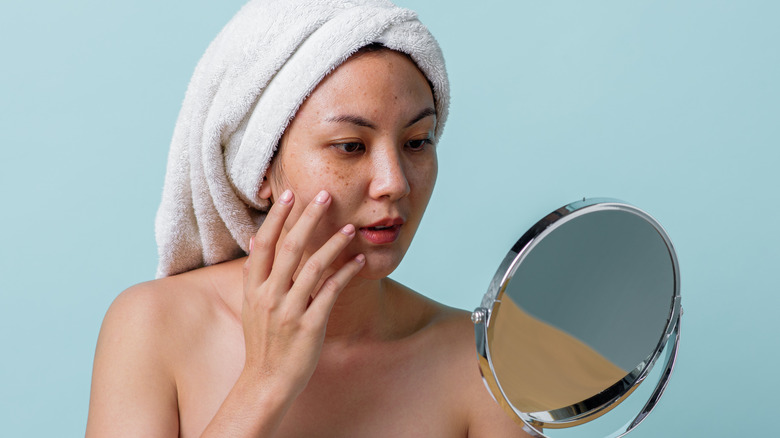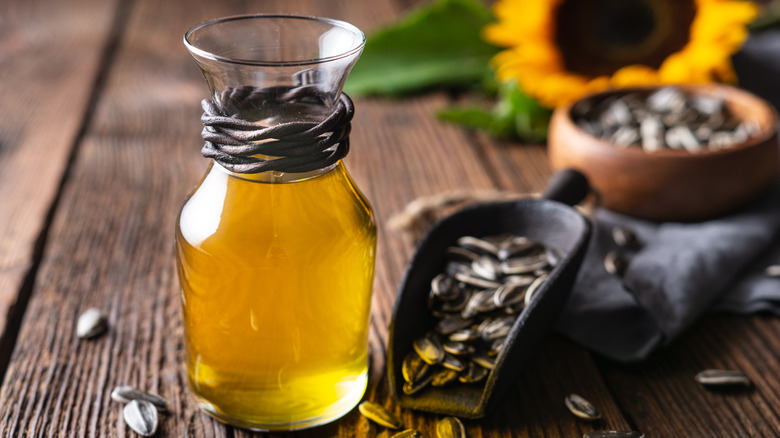What Is Linoleic Acid And How Can It Help Your Skin?
A radiant complexion is always in, and one of the best ways to glow is by taking in nutrients that support skin health. Deficiencies in vitamins, minerals, and trace elements can cause your skin to lose its luster, leading to breakouts, slow wound healing, and dullness. Though it's hard to keep track of which supplements you might need, there are a few that stand out when it comes to keeping your skin healthy. Research from Oregon State University indicates that some of the most powerful dietary additions to nourish your skin are fats and oils, which often contain omega-3 and omega-6 fatty acids.
While much has been said about the efficacy of omega-3 fatty acids for treating skin concerns, omega-6s can get a bad rap. Since Western diets tend to underutilize sources of omega-3s, like seafood, people can end up deficient in them. According to Mount Sinai, "the typical American diet contains 14 to 25 times more omega-6 fatty acids than omega-3 fatty acids," which can cause imbalances and unpleasant symptoms. However, it's important to note that omega-6 fatty acids are essential and should be integrated with omega-3s to achieve balance.
An omega-6 that's been noted for its role in keeping your skin looking its best is linoleic acid. Now, let's uncover the benefits of incorporating linoleic acid in your diet and how to identify the best sources of the essential nutrient.
The protective properties of linoleic acid
There are a few ways that linoleic acid can have a direct impact on the health of your skin. For starters, if you have a few pesky sun spots or other sun-related skin damage, you'll be happy to hear that linoleic acid can help. According to a study published in the Archives of Dermatological Research, clinicians discovered that topical application of the essential fatty acid lightened UV-related pigmentation, or sun damage, in an in vivo study. They also learned that linoleic acid is useful for inhibiting pigmentation on a cellular level, suggesting that dietary consumption could encourage healthy cell turnover.
Linoleic acid is not only useful for lightening sun damage; it's also been found to regulate sebum production, which can promote clear skin. A study that appeared in Human Microbiome Journal investigated linoleic acid's effect on the skin and determined that it plays a crucial role in keeping acne at bay. Without linoleic acid, your skin's sebum production becomes out of balance, and it's easier for blemishes to develop. An absence of linoleic acid can even cause other health problems, including liver and reproductive disease, based on research from The American Journal of Clinical Nutrition.
Deficiency is rare, but because your body can't produce linoleic acid on its own, you'll have to obtain it from your diet or through supplementation. The good news is that it's found in many of our favorite foods, so let's take a closer look at some of the richest sources of fatty acid.
How to get more linoleic acid in your diet
Don't worry about spending time searching at the grocery store; it isn't difficult to track down sources of this omega-6 nutrient. Although most labels won't list specific fatty acid contents, there are some simple ways to identify what's richest in them.
For quick reference of which foods are highest in linoleic acid, think of oils, nuts, and seeds. Harvard Health notes that consuming seven walnuts provides you with 11 grams of linoleic acid. There is no recommended daily allowance (RDA) for linoleic acid, but a report published in Advances in Nutrition suggests that you take between 12 and 17 grams per day. Most of us receive linoleic acid through vegetable oils, like soybean oil, but beef, pork, chicken, and eggs can also provide plenty of this fatty acid.
If you're not keen on oils, nuts, or animal sources of linoleic acid, you can turn to supplements for your needs. One award-winning source of essential fatty acids, Udo's Oil, is beloved by everyone from athletes to actresses. It can complement your diet by contributing three grams of linoleic acid per serving; plus, it's balanced with omega-3 fatty acids from organic flax seed oil. You can mix oils like Udo's into smoothies or dishes like oatmeal to instantly reap the benefits of the powerful nutrients.
Final takeaways about linoleic acid
Most of us aren't likely to encounter deficiencies of omega-6s, as standard diets tend to feature lots of vegetable oils, especially linoleic-rich ones. Whether you've dined at restaurants, markets, or fast food joints, chances are that your food was prepared using vegetable oils like canola, safflower or soy. Per research from the International Food Policy Research Institute, vegetable oils comprise one-10th of the average person's daily caloric intake worldwide. Although the quality of vegetable or seed oils can vary, from minimally processed oils like those in health food stores to industrially manufactured oils used in fast foods, they're ubiquitous on most menus.
However, not everyone has the same nutritional needs or tastes. Those with allergies or absorption issues can speak to their doctors or care team about other ways to acquire essential fatty acids like linoleic acid. Interestingly, a study in The Archives of Dermatology found that internal linoleic acid deficiency could be corrected through topical application of the fatty acid.
If you're on a strict diet or are eliminating food groups, pay attention to your skin and moods. Deficiencies can take years to develop, but if you notice any symptoms arise, it's best to consult with your physician to explore treatment options.



